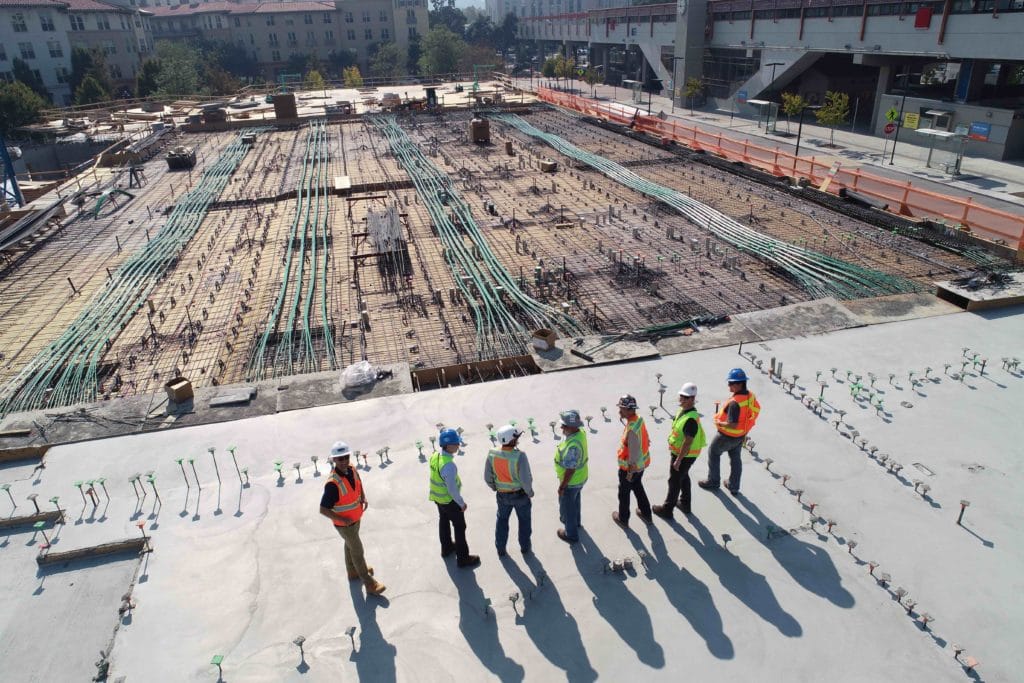In the fast-evolving landscape of design and construction project management, the Last Planner System stands out as a shining example of efficiency. As a collaborative approach, it enhances communication, streamlines workflows, and cultivates teamwork, all while magnifying productivity.
When implementing lean in the design and construction of a commercial project, the Last Planner System (LPS) is an excellent step to start with.
LPS is made up of five steps:
- Milestone Planning
- Phase Planning
- Look Ahead Planning
- Weekly Work Planning
- Learning (to adjust future planning)
Each step can be implemented differently with a new team.
- Milestone Planning
Milestone Planning is usually done at a high level with a scheduler or project oversight team. This phase looks at what should happen and breaks a two or three-year project down into 10 to 15 milestones.
I recommend tracking the start of activities using phrases such as ‘start of foundations’, ‘start of structural steel’, and ‘start of production drywall’ because they focus on what needs to be completed to move to the next step.
A key learning from this phase is to keep the team from overthinking the master schedule. At this point, no more detail than the milestones to project the overall project duration is required. This milestone schedule also lends itself to the actual contract schedule.
2. Phase Planning
Phase Planning is where the team gets together and maps out the details of the work to get to a specific Milestone. You can either map to the start of a phase or to the completion of a phase. I prefer to map to the start of an activity in a specific area of the project. This Phase Planning step is often called pull planning.
What Pull Planning and IKEA Have in Common
How to implement a pull plan with a new team
- Schedule for up to four hours.
- Get the right people there (who know the work and schedule the work)
- Pick a milestone – start with a small work stream, nothing more than two to three months out
- Don't try to pull the entire project in the first meeting
- Spend time with the entire team describing the milestone and gaining alignment, which I found to be a valuable experience.
- Start pulling from the milestone. Focus on logic and duration, not dates.
- Once the pull is complete, run through it in a push method (start to finish) and confirm with the team that it makes sense.
- Get a volunteer to document the result in CPM scheduling software (MS Project, Primavera) and send it to the team within 24 hours for comments and confirmation.
- The first pass is often longer than time allows. Get the team back together and renegotiate or change logic, durations, and overlaps on the CPM schedule to hit the milestone date.
3. Look Ahead Planning
Look Ahead Planning becomes easy if you complete the Phase Planning as described above for the milestone. The team should look at the next four to six weeks (longer if you are in a jurisdiction where plan changes take a long time for review) and make sure that they can complete the tasks. If a task is identified in the Look Ahead view that can't be completed, many people choose to create a ‘constraint log’ to track these items. The constraint log identifies items that need extra work to resolve and assign a person and action plan to them.

Image: Umit Yildirim via Unsplash
4. Weekly Work Planning
Weekly Work Planning and Learning is where I like to start with a new construction team. It is not uncommon to find people resistant because they are new to the concept. I can typically get a team to agree to give me four weeks to try something new with the offer to switch to a traditional meeting after if they like. I haven't had anyone want to switch back after four weeks yet. I introduce the concepts over a couple of weeks, not all at once.
The first week introduces the concept of reliable promising. We ask each team member to document their next week's work by the day and focus on the completion date. I like to project the plan on the wall or screen to allow each person to read the text of what they are agreeing to. This plan is issued via email immediately at the end of the meeting, allowing people to use this document as their work plan. Ideally, every team member uses this same plan as their task list.
In the second week, we introduce the concept of Planned Percent Complete (PPC). I ask each person to go down the list from the previous week and answer the question: “Did you complete this on the end date?” with yes or no. People quickly realize that you are serious about the weekly work plan.
From my experience, many people are not used to being held accountable for specific commitments that they made. I then introduce the concept of variances but don't worry too much about tracking them accurately.
It is important in this phase to let people know this is not a grade (like in school) but a measure of their planning accuracy. In other words, it is a measure of how much a tradesperson can trust the trade before them to meet their commitments so that they can rely on them to schedule their own work.
Week three starts with detailed variance tracking. We put a variance category for each missed task (ie labor not available, material not available, previous trade not complete, owner decision not made, etc). The focus this week is on countermeasures for the variances.
It is important to let the team know that this tracking process will help them fix their issues in the field, and doesn’t have the purpose of blaming them and creating a paper trail of failure.
Often, the variances are out of their control and the project managers can intervene to improve the work environment in the field. This is where the foreman starts to see the true value – a way to get their leadership to clear their barriers.
Week four is when I usually introduce the concept that finishing early is also a miss from a planning point of view. If a trade finishes a day early without giving the follow-on trade ample notice, the team loses the opportunity to pull in the schedule a day. This is usually an eye-opener for the team and creates good discussion.
Weeks five and six will help cement the process for the team and should be done in a shadow/mentor mode with the team running the process themselves and making minor tweaks and suggestions. This includes reviewing the PPC, Variances, and Work Plans when they come out to make sure the team is maintaining enough detail in their plans.
Taking Advantage of IPD Lessons Learned
5. Learning
Tracking the reasons why things don’t get done will help the team to make adjustments and improve the process. These reasons (often called variances) may be things like “not enough material”, “not enough labor”, “previous work not complete”, design direction pending”, “inspections”, and various other items that could be job specific. A high-functioning team will pay close attention to these variances and use root-cause analysis to improve the planning process.
Conclusion
The Last Planner System is a great place to start the implementation of lean processes on a construction project. When implemented with diligence and consistency, any project will see near-immediate improvement in workflow reliability, schedule performance and worker morale. For those who are still not convinced, I suggest giving it a try and see what happens.
Discover how to take your construction project to the next level
The introductory online course to integrated project delivery, designed by the Integrated Project Delivery Alliance (IPDA) and LeanIPD, is for intermediate-level construction professionals who want to deliver complex projects on time, on budget, and with the original intended scope and value proposition.
For those who want to dive deeper, the advanced online course delivers the specifics of Integrated Project Delivery and teaches project owners how to set up and manage their construction projects with IPD. From aligning incentives through shared risk-reward structures to implementing target value design and understanding change orders in an IPD framework, this course will provide the skills to take construction projects to the next level.
Feature image: Scott Blake via Unsplash
James is an expert in the set-up and structure of large, complex capital projects using Lean and Integrated Project Delivery to drive highly reliable results.
He has negotiated IPD contracts and delivered over $650M in complex healthcare projects as an Owner's Representative with multiparty contracts, aligned team incentives and collaborative delivery models.




